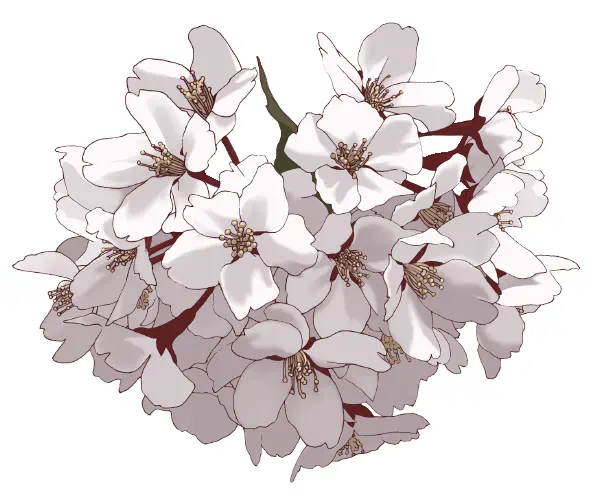cherry blossoms
Small flowers of any of several trees of the genus Prunus, especially the Japanese Cherry (Prunus serrulata, the suffix a Latin rendering of sakura). Usually seen falling or scattered as petals.
Cherry blossoms, especially the pink ones of the Prunus serrulata, are a significant visual motif in Japanese culture; as their period of flowering that lasts little more than a week during the spring is thought to symbolically convey an awareness of the brilliant, yet impermanent nature of life. The term mono no aware (物の哀れ, literally 'the pathos of things') was coined by 18th century scholar Motoori Norinaga to describe this concept as a theme found in classical Japanese literature, and associated it with the cherry blossom motif.
The white-colored autumn and winter blossoms (冬桜, fuyuzakura) of the higan cherry tree (Prunus subhirtella autumnalis) are a notable variant, coming into bloom during those seasons.
In anime and manga, besides straightforward symbolization of youth and verve, the symbol may be used to denote gentle and/or affectionate characters; though this usage can sometimes be ironic. Cherry trees in anime art are almost always drawn in bloom, but the actual cherries don't grow until the blossoms are long gone.
Not to be confused with plum blossoms. Cherry petals have slits at the ends of the petals, while plum petal ends are round.
Examples
另请参见
External links
The following tags are aliased to this tag: cherry_blossom, cherry_trees, and sakura_blossoms (learn more).
樱花,尤其是粉红色的樱桃花,是日本文化中重要的视觉主题。因为它们在春季的花期持续一周多一点,被认为象征性地传达了对生命辉煌但无常本质的认识。 “物の哀れ”(物の哀れ)一词是由 18 世纪学者 Motoori Norinaga 创造的,将这一概念描述为日本古典文学中的一个主题,并将其与樱花主题联系起来。
彼岸樱花 (Prunus subhirtella heavenalis) 的白色秋季和冬季花朵 (冬桜, fuyuzakura) 是一个值得注意的变种,在这些季节开花。
在动画和漫画中,除了直接象征青春和活力外,该符号还可以用来表示温柔和/或深情的角色;尽管这种用法有时可能具有讽刺意味。动漫艺术中的樱花树几乎总是在盛开的时候画出来的,但真正的樱桃要等到花朵早已谢尽后才会生长。
不要与梅花混淆。樱花花瓣的花瓣末端有裂缝,而梅花花瓣的末端是圆形的。
以下标签是此标签的别名:cherry_blossom、cherry_trees 和 sakura_blossoms(了解更多)。

